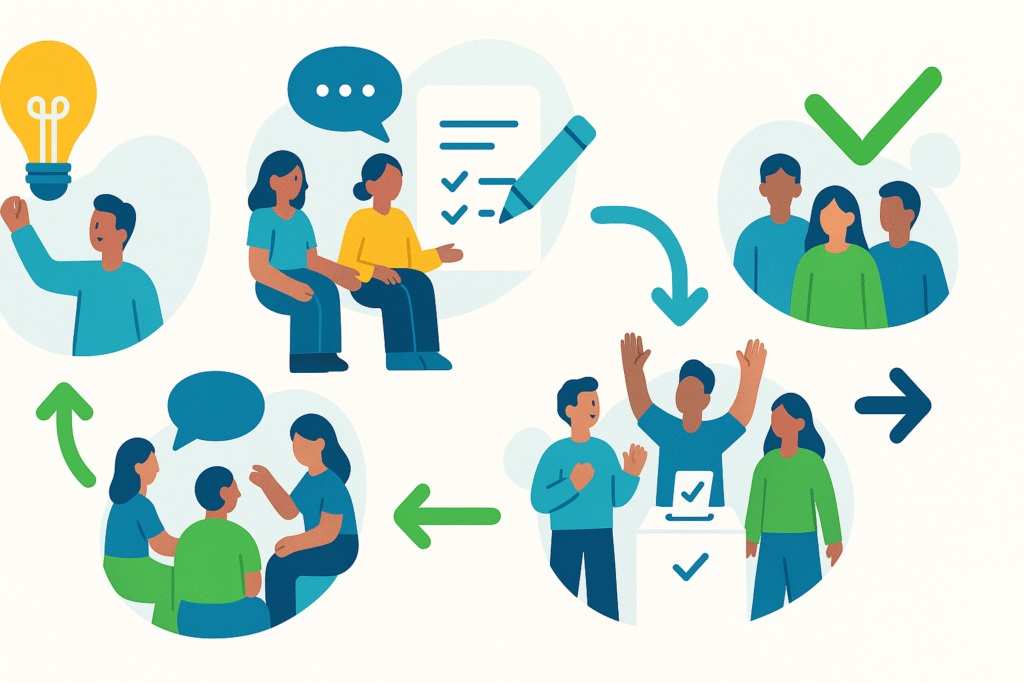
Introduction
In recent years, civic participation has found new forms thanks to digital platforms for participatory democracy. But how do you actually build a participatory proposal that is clear, inclusive, and capable of generating consensus? In this guide, we will walk you through the process step by step, from defining the problem to sharing the proposal with the community.
1. Clearly Define the Problem
Every participatory proposal starts with a real and shared issue. Without a well-defined problem, the proposal may be perceived as vague or superficial.
- Identify the main topic (e.g., mobility, environment, public spaces).
- Explain why the problem matters to the community.
- Use data or testimonials to make it more tangible.
Example: instead of writing “improve transportation,” specify “lack of safe bike lanes connecting downtown to the northern district.”
2. Engage the Stakeholders
A proposal should not be created in isolation. Engaging stakeholders from the very beginning makes the idea stronger and more widely supported.
- Citizens and residents
- Local associations
- Public administrators or institutions
- Field experts
You can use digital tools (forums, surveys, online groups) or in-person meetings (neighborhood assemblies, workshops).
3. Structure the Proposal with Clear Goals
A well-built proposal is not just an idea but a plan with specific objectives.
Essential Elements
- A short, clear title → e.g., “A new bike lane for Via Roma.”
- Problem description → 2–3 paragraphs, with data or examples.
- Concrete goals → what do you want to achieve? (e.g., reduce traffic, improve safety).
- Community benefits → why everyone should support it.
Tip: platforms like Decidim or Consul already provide standard templates that help ensure nothing is missing.
4. Use Inclusive and Clear Language
Clarity is crucial. A participatory proposal should not look like a technical report but should speak to all citizens.
- Avoid bureaucratic or overly technical jargon.
- Use short, direct sentences.
- Provide real-life examples.
- Keep a positive and constructive tone.
5. Support with Data, Images, and Sources
A convincing proposal is based on evidence.
- Add statistics or reports (e.g., national data, university studies).
- Use maps, photos, or infographics to improve comprehension.
- Cite reliable sources with external links.
Example: if you talk about urban pollution, link to resources like ISPRA or Eurostat.
6. Open the Proposal to Feedback
A participatory proposal is not a “closed” text but a living document open to comments and improvements.
- Enable commenting on the proposal.
- Host discussions in public meetings or assemblies.
- Accept suggestions and integrate valuable contributions.
On platforms like Concorder, it is possible to comment on each paragraph and vote on ideas, making the process even more transparent and collaborative.
7. Share and Promote the Proposal
Even the most brilliant proposal will have no impact if it remains invisible. Communication is a key part of the process.
- Share the proposal on social media, local forums, and thematic websites.
- Create a shorter version (flyer, post, short video).
- Ask associations or groups to support and relaunch it.
- Use thematic hashtags (e.g., #participation, #digitaldemocracy).
Conclusion
Creating a participatory proposal is not just about writing a document: it means activating a process of listening, dialogue, and collaboration. The key is to proceed step by step: define the problem, involve the right people, structure concrete goals, communicate clearly, and stay open to contributions.
With digital tools like Concorder, citizens and communities can now turn ideas into concrete and shared proposals, increasing transparency and the quality of public decisions.


